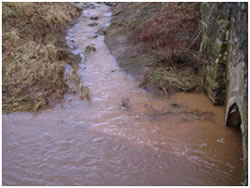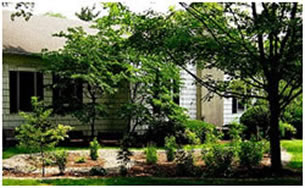PROJECT TASKS
Stormwater Best Management Practices (BMPs)
Four stormwater BMPs (Rain Gardens, Detention Basin Retrofitting, Roadside Ditch Retrofitting and Vegetative Buffers) were selected from the NJ Stormwater BMP Manual (NJDEP, 2004) to reduce pollutant loads from stormwater runoff and other municipal sources. Literature review was conducted to assess the pollutant load reductions that can be achieved by the selected BMPs. The implementation costs for these BMPs were estimated based upon the practices of installing and maintaining those BMPs in the region. The detail sheets were developed to document the costs and effects of the selected BMPs in selected locations in the watershed.
The watershed was divided into eight subwatersheds based on the location of seven water quality monitoring stations. The water quality monitoring data were used to determine the pollutant loads from each of thesubwatersheds whose outlet is represented by each of the seven sampling locations. The subwatersheds were prioritized for implementing BMPs based on total phosphorus and fecal coliform loads from the subwatersheds.
Roadside Ditch: A Source of Contamination
Residential Rain Garden
The neighborhoods for rain gardens and vegetative buffers were identified. The detention basins were prioritized for retrofitting based on the type of vegetation on the basin bottom, the general condition of the basin, the configuration of the basin outlet structure and the condition of the low flow channel and under drain. The roadside ditches were prioritized for retrofitting based on the type and condition of the ditches and the condition of the culverts in the ditch. The information regarding the detention basins and roadside ditches were collected through the stormwater infrastructure inventory.
Progress and Status
- Selection of stormwater BMPs was completed by December 2009.
- Ranking subwatersheds was completed by March 2010.
- Prioritizing Stormwater BMPs was refined and completed by March 2011
- Stormwater BMP detail sheets was refined and completed by March 2011
Results and Outcomes
Although total phosphorus and fecal coliform contamination is prevalent throughout the entire watershed, ranking of the subwatersheds and existing stormwater infrastructure provides the stakeholders within the region a prioritization strategy for addressing the nonpoint source pollution problems within the watershed. For example, Subwatershed N1 received the highest ranking for both total phosphorus and fecal coliform. One strategy would be to identify the best opportunities within this subwatershed for implementing the selected BMPs. The opportunities for installing rain garden and vegetative buffers are identified for each subwatershed. The detention basins and roadside ditches located in each subwatershed are also prioritized. Retrofitting would be to focus on these detention basins and roadside ditches with high priority. For each BMP, detailed design and analysis are presented for selected locations in the watershed.
For details please read:
- Stormwater BMPs and Prioritization Report
- Subwatershed Priority Ranking
- Rain Gardens
- Residential Neighborhoods Suitable for Rain Gardens by Subwatersheds
- List of Residential Neighborhoods Suitable for Rain Gardens by Subwatersheds
- Detention Basin Retrofits
- Distribution of Detention Basins by Subwatersheds
- Prioritization List of Detention Basins by Subwatersheds
- Roadside Ditch Retrofits
- Distribution of Roadside Ditches by Subwatersheds
- Prioritization List of Roadside Ditches by Subwatershed
- Vegetative Buffers
- Distribution of Neighborhoods Suitable for Vegetative Buffers
- Stormwater BMP Detail Sheets
- Rain Gardens
- Residential Rain Garden: Description Design
- Roadside Rain Garden: Description Design
- Commercial Rain Garden (Shoppes): Description Design
- Commercial Rain Garden (ShopRite): Description Design
- Detention Basin Retrofits
- MDB-0035: Description Design
- MDB-0054: Description Design
- MDB-0069: Description Design
- MDB-0136: Description Design
- MDB-0150: Description Design
- Roadside Ditch Retrofits
- SD-0187: Description Design
- SD-0376: Description Design
- SD-0389: Description Design
- SD-0525: Description Design
- SD-0618: Description Design
- Vegetative Buffers: Description Design

